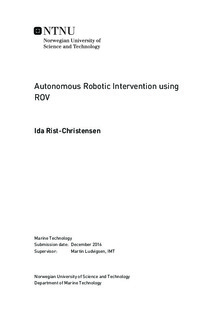| dc.description.abstract | This thesis proposes a semi-autonomous agent architecture for a Remotely Operated Vehicle
(ROV). The purpose of this architecture is to apply control strategies from Autonomously
Operated Vehicles (AUVs) onto ROVs, in order to perform certain subsea operations autonomously. As a result, an autonomous ROV (AROV) can be used to perform tasks that
are currently performed by human divers or by an operator through remote control. The
architecture increases the safety, reduces the costs, and minimizes the need for human intervention.
The agent architecture focuses on a general subsea operation, the approach and localization
of a Structure Of Interest (SOI) located on the seabed. For this purpose, a hybrid control
architecture is developed. The term hybrid describes the combination of deliberative and
reactive control layers. The deliberative layer accounts for the slowly moving behavior
components, taking the ROV from the surface to the SOI. It is comprised of six underlying
system states, dividing the mission into sub-problems. The states follow the mission anatomy
in the order: (1) Launch, (2) Descent, (3) Transit, (4) Sonar tracking, (5) Camera tracking
and (6) Inspection/Intervention. The reactive layer takes care of the contingency handling,
i.e. the behavior of the vehicle when it is exposed to unexpected situations. The reactive
behavior implemented in this thesis is Obstacle/Collision Avoidance, using computer vision
techniques for detection of the obstacle. The reactive layer has priority in the control
execution layer, which composes the third layer of the agent architecture, by deciding
which behavior should be carried out.
The capability and limitations of the agent architecture are demonstrated through software
simulations and full-scale field experiments on the research vessel R/V Gunnerus using the
ROV Sub Fighter 30 k. Some behaviors are only simulated, such as feedback navigation
using sonar and camera data, and autonomous maneuvering of the manipulator s arm. This
thesis aims to provide the architecture framework, and consequently, the optimization of the
sub-behaviors has not been considered a priority of this work. Optimization of each state
should be considered for future research on the subject. The result is an architecture steering the vehicle autonomously, according to the implemented deliberative and reactive behaviors. The agent architecture has the possibility of adding and removing an infinite amount of these behaviors, enabling for a variety of subsea operations. The results were quite satisfactory, both from simulations and field work. Deliberative and reactive behaviors were tested separately and simultaneously, using known SOIs and obstacles in the Trondheim fjord. All results confirmed the expected autonomous behavior of the vehicle, moving from the surface until the localization of the SOI and stationkeeping in front of it, using the sensors and equipment available.
This thesis shows that the agent architecture is a well-designed framework for increasing
the autonomy in ROV operations. Results imply that further research should be carried
out on the topic, such as optimization of each sub-behavior, implementation of stereo vision
position estimates and autonomous interventions/inspections. This thesis is considered a
pioneering contribution to autonomous ROV interventions, adding new results to previous
research. | |

